2015
The Windy Way
The high winds from last week sure got everyone’s attention. There were reports of near zero visibility, with no snow, fog, or rain to speak of, meaning that everything that blew was soil and debris/crop residue. This immediately prompted people to ask questions about how that day related to the dust bowl, particularly if you knew someone who grew up in that era.
That storm came at one of the worst possible times for our soils. We were already dry, and so the coarse textured soils were loose on top and ready to move. Soybean harvest was just wrapping up and corn harvest had begun so there was plenty of exposed soil and plant residue throughout the state. Figure 1 is a picture taken near Carrington where the wind actually created soybean drifts in the ditch. This particular drift was 3 feet high in some places. Even if a person avoided tilling soybean fields to preserve moisture, the exposed soils will be at risk of blowing all fall and winter where there is no protection.
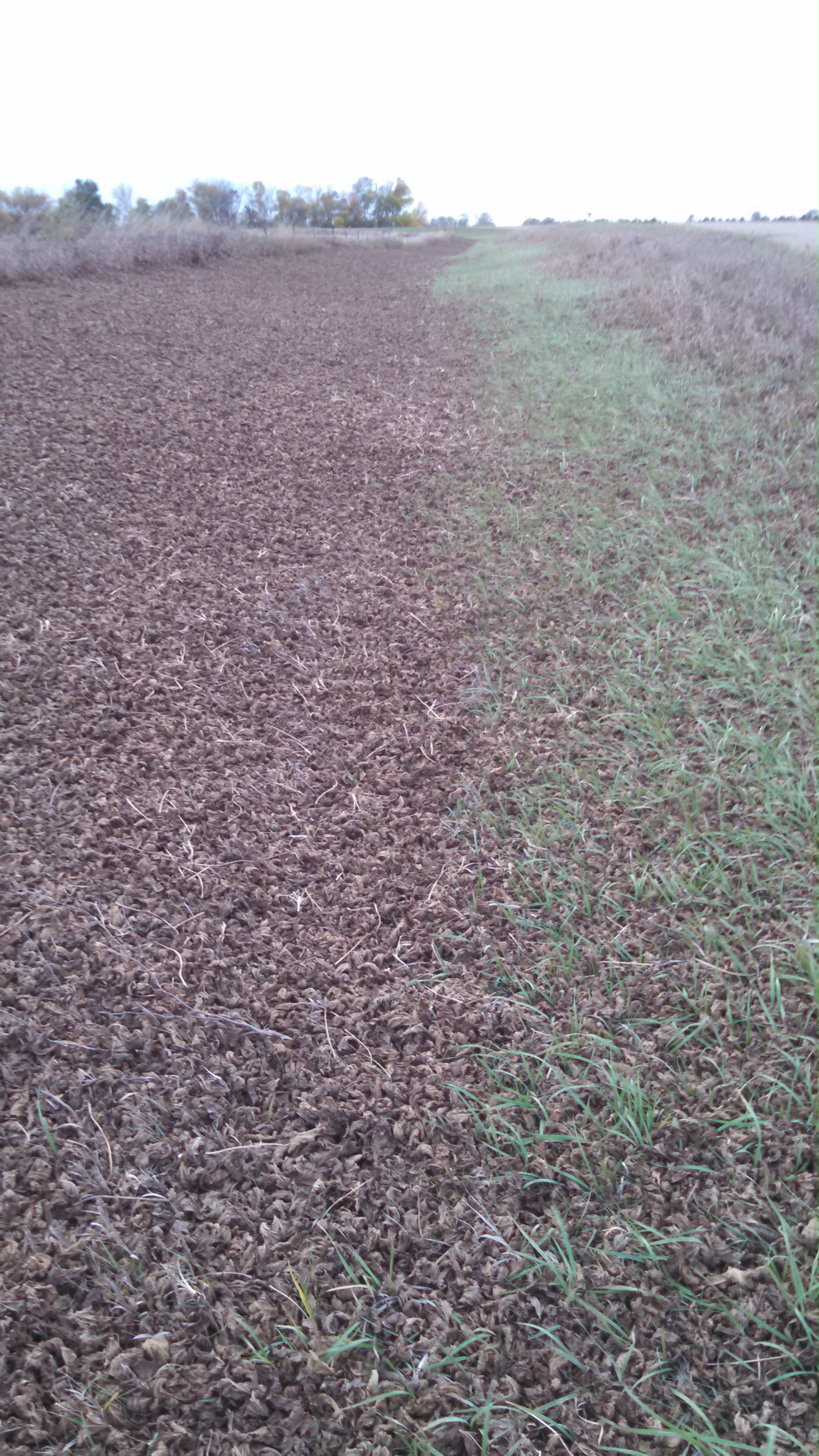
Figure 1.
Unfortunately, even sturdier residue, such as wheat and barley stubble, was also susceptible to the wind. If you have winter wheat planted this fall, you should be checking that. We had instances of winter wheat and winter rye where our stand was significantly reduced due to the wind. These cereals were planted into barley stubble, but you could still see that the wind had blown away some of the soil that covered the seeds in the furrow, and the plants along with it. Beyond that, winter cereals certainly sustained “sandblasting” damage from the soil particles shooting through the air that day. The real concern is whether the crown is still intact in the ground, and if it is intact, how well it will survive exposure to more wind, drought, and cold temperatures throughout the fall and winter.
To end with, here are some interesting facts about wind:
- Wind turbines are one of the few power sources that don’t use water.
- One of the biggest drivers of wind is the heat difference between the equator and the north/south pole.
- Australia holds the world record for wind speed at 253 mph, though I think my house must hold the second highest record.
- Wind chill essentially describes the rate of temperature change that an object experiences in the open.
And finally,
- How would you describe a dust storms’ sense of humor?.......very dry.
Mike Ostlie
Research Agronomist
Does Your Silage Pile Have A Fever?
Making corn silage is prevalent this time of year. Good quality silage can substantially help a increase the energy density of a cattle ration during cold winter months in North Dakota. Putting up high quality silage starts with chopping silage at a desired 62-65% moisture. Ensiling a greener, higher moisture corm plant above 67% moisture can lead to liquid seepage from the silage pile and poorer fermentation with the wrong type of acids produced. Ensiling silage with corn plant containing less than 60% moisture will lead to an undesirable ensiling process. While the ‘dry ‘pile might eventually create a silage smell, it may have a silage smell that smells more like dried earthy, caramel smell than the sweet crisp smell of well fermented silage.
Silage that was chopped too dry is difficult to pack well. Packing silage is important since squeezing the air out of the pile allows better fermentation. The problem with poorly packed dry silage is that the pile contains a lot of air.
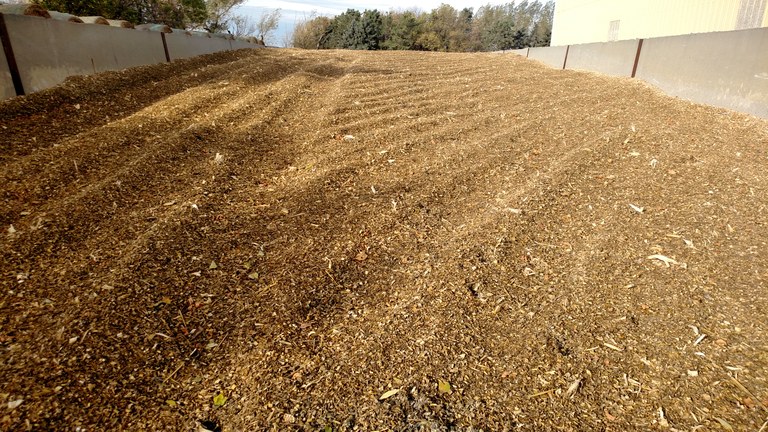
In the ensiling process, the microbes will first use up the air with in the silage pile. This first step is the respiration phase and a lot of heat is created. This phase will last until there is no oxygen left. In the absence of oxygen, the microbes will switch to fermentation mode. A co-product of fermentation is the organic acids that pickle the silage. Eventually the acids will increase in concentrations, and the pH of the pile will become more acidic. When the pH drops enough, the fermentation stops and the ensiling process in done.
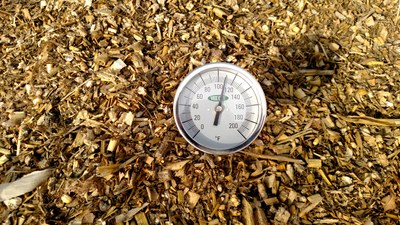
A sign of good fermentation is the relatively low temperature involved with the increasing acid content. High temperatures are found in silage piles that contain too much oxygen due to poor packing or corn silage that is cut too dry. High temperature (135 degrees F) indicates poor ensiling. High temperatures lead to nutrient loss due to respiration.
Using a 3 foot long temperature probe, two silage piles had temperatures recorded on a daily basis. At the 3 foot depth, they were warm but not hot. At the 6 inch depth these uncovered piles were heating and losing feed value. These piles were packed at around 62% moisture. The insides of the piles were fermenting nicely. The outside 6 inches were in respiration. To reduce heating in the outside 6 inches next year, covering the silage pile with a combination oxygen limiting membrane and plastic cover is encouraged.
Karl Hoppe
Area Extension Livestock Specialist
Soil Sampling for Fertilizer Application Plans for the 2016 Growing Season
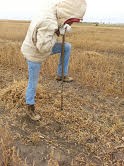
Following are some things to keep in mind while soil sampling this fall:
- A soil sample which does not represent the area being sampled will be misleading and result in over or under-application of fertilizer. For example, soil sampling a plowed field. It is therefore very important to collect and handle soil samples properly.
- Soil sampling is encouraged immediately following early crop harvest, including winter wheat, canola and spring wheat, otherwise soil sampling after chisel plowing stubble can result in unreliable soil test results. Potassium nutrition is complex.
- Soil clay chemistry plays a much larger role than taught in school. Soil minerals such as potassium feldspar, prevalent in many ND soils is an important contributor to seasonal plant nutrition than previously thought. Soil sampling schedules should be as consistent as possible. For example, soil exchangeable potassium will test lower following corn than following soybeans, since seasonal potassium uptake by corn is larger than for soybeans during the cropping season.
- Soil K is highest in the early spring, with rapid or gradually decreasing K into June, holding relatively steady at a low level until fall when rain leaches K from standing stubble before and after grain harvest, which causes soil K values to again start to increase. Potassium soil test may be done once every 3-4 years for most soils (except low K sands).
- Soil P, Zn, and pH are relatively more stable over a growing season so time of year is not very important. These three factors are especially important for some crops grown after beets, and canola, which don’t form mycorrhizal association with their roots.
- Fall soil sampling results for NO3-N and sulfur are similar in most years to spring sampling. However, warmer than normal winters followed by an early spring combined with good soil moisture could increase NO3-N and SO4-S levels through organic matter and residue mineralization. Green sugar beet leaves or other crop residues with relatively high N content may also contribute to early mineralization and increase spring NO3-N levels compared to a fall soil sampling. In sandy soils with high rainfall or snow-melt following a fall sampling, levels of NO3-N and S in the spring compared to a fall sampling may decrease as nitrate and sulfate are leached out of the sampling zone. In most situations, however, fall sampling is a good guide to N and S application. Note that sulfur analysis in soil is not reliable.
Acknowledgement: Dave Franzen.
For further reading, please visit Dr. Dave Franzen’s publications on soil sampling at https://www.ag.ndsu.edu/cpr/soils/soil-sampling-following-early-crop-harvest-08-13-15\ and Soil sampling as a basis for fertilizer application.
Please visit NDSU website on how to soil sample and submit for analysis at: https://www.ndsu.edu/soils/services/soil_testing_lab/how_to_soil_sample/.
Jasper.Teboh@ndsu.edu
Soil Scientist
Avoid Harvesting Too Dry Soybean Seed
The standard seed moisture for soybean is 13%. It appears common this season that soybean producers are harvesting soybean considerably less than 13%. What difference does harvesting and selling soybeans at 8% or 9% moisture mean to your bottom line? If you sell soybeans at 8% moisture, you're losing about 5.4% of your yield; at 9% moisture, it's 4.4%; at 10% moisture, 3.3%; at 11% moisture, 2.3%; and at 12% moisture, it's 1.1% yield. For a field that's yielding 35 bushels/acre at 13% moisture, harvesting it at 10% moisture results in selling 1.2 fewer bushels/acre. With soybeans priced at $8/bushel, that's a loss of $9.60/acre.
So what can you do? We know that it is impossible to harvest all your soybeans at exactly 13%, but that should be your goal. Consider these soybean harvest tips:
- When harvesting tough or green stems, make combine adjustments and operate at slower speeds. Harvest at a slow pace and make combine adjustments to match conditions several times a day as conditions change.
- Begin harvesting at 14% or 15% moisture. What appears to be wet from the road may be dry enough to harvest. Try harvesting when some of the leaves are still dry on the plant; the beans may be drier than you think. Soybeans are fully mature when 95% of the pods are at their mature tan color.
- Harvest under optimum conditions. Moisture content can increase by several points with an overnight dew or it can decrease by several points during a day with low humidity and windy conditions. Avoid harvesting when beans are driest, such as on hot afternoons, to maintain moisture and reduce shattering losses.
- Avoid harvest losses from shattering. Four to five beans on the ground/square foot can add up to one bushel/acre loss. If you are putting beans in a bin equipped for drying grain, start harvesting at 16% to 18% moisture and aerate down to 13%.
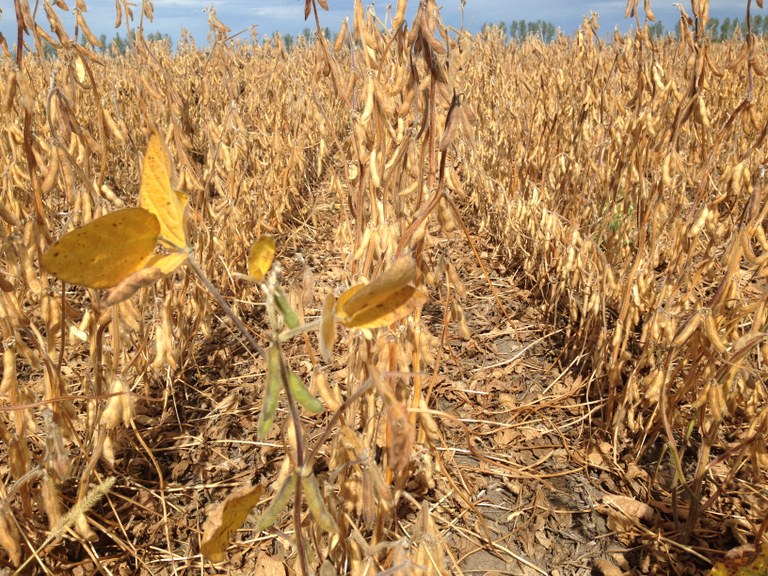
Mature Soybeans
Greg Endres
Area Specialist, Cropping Systems
Fall Tree Care
One of the sure signs of autumn is fall foliage in the landscape as woody plants prepare for winter. Here are some things that can be done to help prepare your trees for the long season ahead:
- PLANT. Yes, fall is a great time to plant trees. Cooler temperatures enable plants to acclimate to a new home without the stress of high air and soil temperatures. While selection at nurseries may be limited, trees are often on sale in the fall. Make choices that are suitable for North Dakota’s alkaline soils – don’t buy something just because it sounds like a good deal. Trees are a great investment! For winter interest, choose a tree with interesting bark or fruit that hangs on the tree beyond fall.
- DON’T FERTILIZE newly planted trees, and only apply slow-release fertilizers on established trees. Applications of nitrogen will encourage new tree growth which won’t have a chance to harden off before winter. If you’re fertilizing your lawn, you’re also fertilizing any trees nearby. Trees have a root spread equal to or greater than the height of the tree.
- WRAP newly planted trees with brown kraft paper, starting at ground level and working your way up the tree to the first branch. White plastic tubing can also be used. This protects young trees from winter sunscald on the southwest exposure of the trunk, and will also deter rodents from feeding on the bark. Trees most susceptible include fruit trees, mountainash, honeylocust, maples and linden. Tree wraps should be removed in the spring.
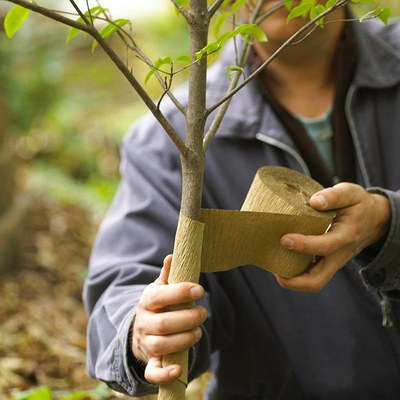
Applying paper tree wrap before winter. Photo from Lowe's website. - WATER trees before freeze-up. Tree roots remain active until soil temperatures dip below 40 degrees. Watering is especially beneficial for evergreens, which transpire tiny amounts of moisture through their needles throughout the winter months.
- HERBICIDE APPLICATIONS should be done with caution around trees. In last week’s Center Points on Fall Lawn Weed Control, Kathy mentioned that herbicides are most effective on lawns in the fall, but also stated that some herbicides can be detrimental to tree roots, especially with repeat applications. Spot spray, if possible. Learn to tolerate a few weeds.
- PRUNING is best done when trees are dormant, so leave that task until early spring. Routine pruning in early spring before buds swell enables the tree to naturally seal off pruning wounds most effectively. Broken branches should be properly pruned as soon as they are noticed. Don’t use pruning sealer, tar or paint on any tree cuts or wounds. A proper pruning cut doesn’t require sealer, and no amount of sealer can fix a bad pruning cut.
- FIREWOOD. For those who burn wood, fall is a popular time to harvest and cut firewood, or purchase it from a seller. Keep invasive pests away by purchasing or harvesting firewood locally. Transport of infested firewood is most likely how emerald ash borer will make its way to North Dakota. Don’t move firewood. Protect North Dakota’s trees!
- Links for tips on planting, pruning, and maintaining trees:
http://treesaregood.org/treeowner/treeownerinformation.aspx
- Information on NDSU Woody Plant Improvement program and NDSU releases:
https://www.ag.ndsu.edu/plantsciences/research/woody-plants
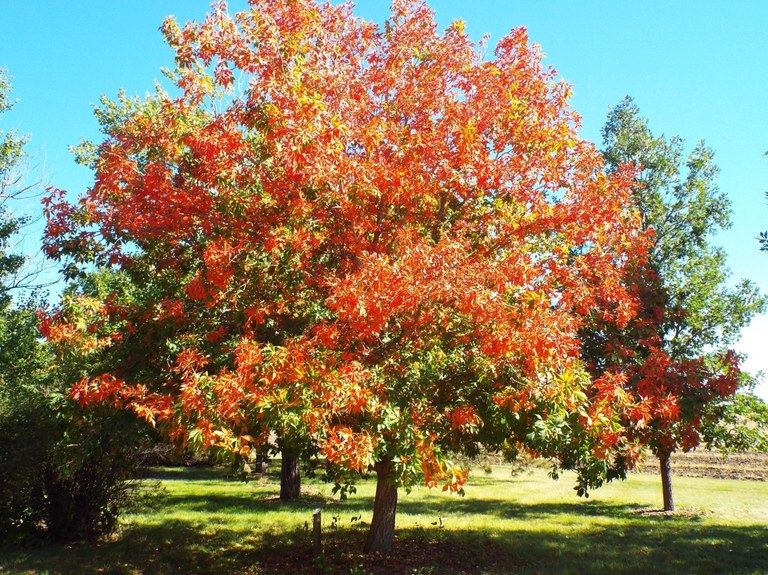
Fall foliage on Ohio buckeye at CREC. Photo by Gerri Makay.
Gerri Makay
ND Forest Service
Community Forestry Program Manager
Gerri's office is located at the CREC.
Fall Lawn Weed Control
There is still time to do some lawn care this month and to make some plans for next year.
FALL is the BEST TIME of the year to control weeds in your lawn. Next year’s dandelions have germinated and right now, all weeds are moving nutrients into their roots to help them make it through the long winter. Broadleaf herbicides will also be taken to the roots. As well as being the most effective time to control weeds, a fall application of herbicide will do the least amount of damage to the rest of the plants in your yard and your neighbors’ yards since the garden plants are not growing as actively as they do in the spring. ‘Weed and feed’ products are not recommended – they're not as effective, leads to herbicide runoff and can easily track indoors.
Spring and summer are terrible times to apply weed control. Broadleaf herbicide ingredients such as 2,4-D, dicamba, and MCPP can have unintended effects away from where you applied them. First, there is physical drift: if you apply small droplets in windy conditions, the wind can move the herbicide away from where you applied it. A second effect is vapor drift: the applied herbicide volatilizes into a gas and travels away from where you applied it. If you smell herbicide, it means it is coming onto your property.
The herbicide that is applied to your lawn or the field near you can affect the young leaves of plants in the neighborhood. If applied during the spring and early summer, you and your neighbors may see plant leaf effects like these:
Grapes: Box Elder: Tomato: Source: Bugwood.org
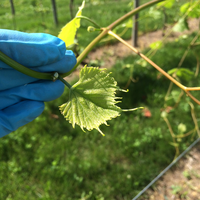
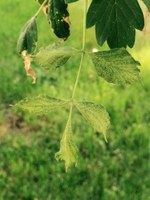

Plants that experience repeated stress from herbicide exposure tend to be less vigorous and can die. Box Elder and Hackberry trees, which are suited to our dry climate, seem to be especially sensitive to these types of herbicides. Tomatoes, eggplants, potatoes and melons are also easily affected by drift. If your garden is heavily affected, consider whether you should eat its produce; drifted lawn and field crop herbicides are not labeled for application to food plants.
Finally, if you are applying a broadleaf herbicide that contains dicamba, do not apply it repeatedly near tree roots. Tree roots extend beyond the canopy of the tree. Dicamba builds up in the soil and kills trees in North Dakota every year.
Take Away:
- Apply lawn herbicides as little as possible each year.
- A one-time, Fall application will be most effective.
- Don’t use “Weed and Feed” products. It tracks indoors and is applied to too much of the lawn. Just spot spray where you need it.
- Spraying: Wear Boots! Wear Long Sleeves! Wear Gloves! Back AWAY from the application area – DON’T walk INTO it! READ the LABEL! UNDERSTAND the LABEL. These are not chemicals to mess around with. Don’t let your children or pets onto a lawn before it dries. Or better yet, until you’ve cut it one more time.
- It is impossible to control 100% of weeds. It is OK!
Some interesting lawn links:
Home Lawn Problems and Solutions for North Dakota
A quick overview of lawn care and weed control
Reasons to avoid ‘weed and feed’ products
Kathy Wiederholt
Fruit Project Manager
Plot Harvest Equipment
Along with field-scale combines with pickup and straight-cut headers for Foundation seed production, the CREC also owns or operates 7 plot combines. That may seem like a lot of equipment, but we harvest close to four hundred trials (each with 6 to 85 treatments and 3-6 replicates) at the Carrington REC and the Oakes Irrigation Research Site, and at trials at locations such as Cathay, Dazey, Fingal, Hurdsfield, LaMoure, Melville, Park River, Prosper, Robinson, Sykeston, and Wishek, as well as near Ada, East Grand Forks, and Thief River Falls, Minnesota. We also cooperate with the REC’s at Langdon and Williston, using their equipment to harvest jointly-managed plots at those locations.
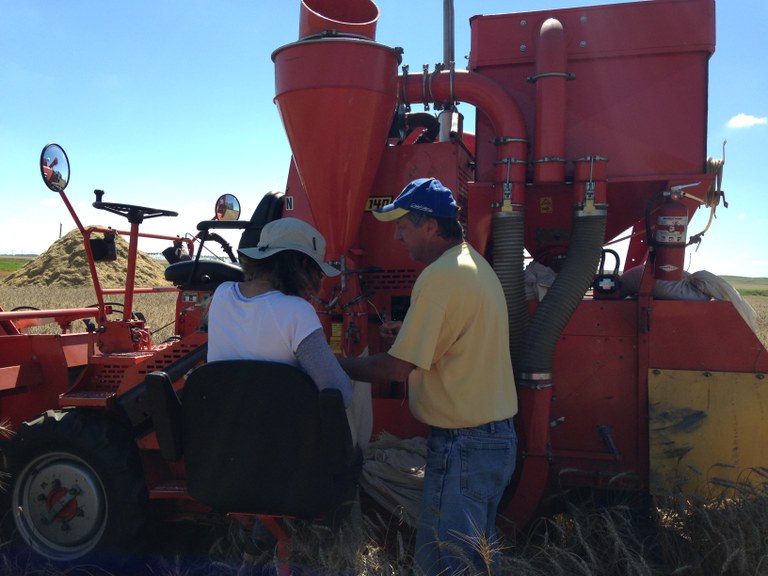
Most of our plot combines have straight-cut headers that cut a 4 to 5-foot swath, but some crops (like canola and buckwheat) are swathed with our plot-scale windrower. Plot combines have long crop dividers on the headers that carefully separate the rows so each individual plot is harvested and information record separately and accurately. Lifters at the sickle bar aid in crop pickup for some crops. Each plot combine carries two operators, one to drive the equipment and control the ground speed and processing controls, and another to collect individual samples and tie bags. (Another Center Points blog (click here) describes the tagging and organization that occurs before and after the harvest operation.)
Sunflower and corn combines take two rows at time. Some seasons, the sunflower harvest is so close to other small grains that we collect heads by hand and run them through the harvesting equipment later in the winter. New to our equipment line-up is a (used) modified beet lifter: watch for another Center Points blog post about beet equipment.
Mechanically and internally, our research plot combines bear strong resemblance to field-scale combines, with a feeder house, separator, and sieves. By design, research plot combines clean out much more thoroughly than field-scale equipment, with limited spots for seed cross-contamination.
While most of the plot-specific equipment technology is German, some parts can be sourced locally. Specialty items are only available from a few manufacturers, so our agronomy technicians must find innovative modifications or fabricate parts to keep our combines operating properly.
Because our plot combines don’t have straw choppers, we “clean up” our post-harvest plots by running across the area with a conventional combine, and harvest guard rows at the same time.
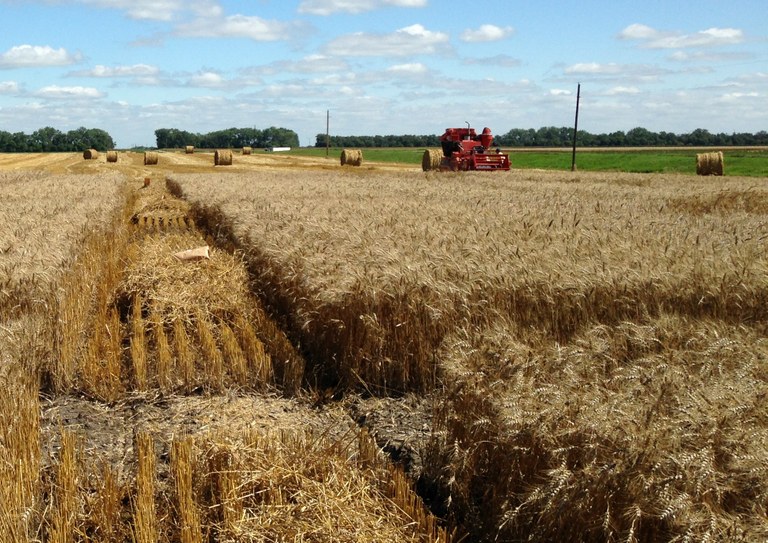
Most of our research plot combines don’t have cabs, so harvest crews often wear protective gear such as dust masks, goggles, sunscreen and insect repellent as they work.
Extra care is taken between increase fields and research trials to clean seed and dust from combines to prevent cross-contamination. Certified organic trials have their own dedicated equipment and also undergo rigorous cleaning between uses to insure preservation of identity-preserved seed lines. Our plot combines have on-board compressors and hoses for in-field cleaning.
From the 2015 plots, we expect to harvest the following grains, legumes, and oilseeds: barley, buckwheat, camelina, canola, chickpea, corn, cowpeas, crambe, dry bean, durum, einkorn, emmer, fababean, field pea, flax, lentil, oats, rice, rye, safflower, soybean, spelt, spring wheat, sunflower, and winter wheat.
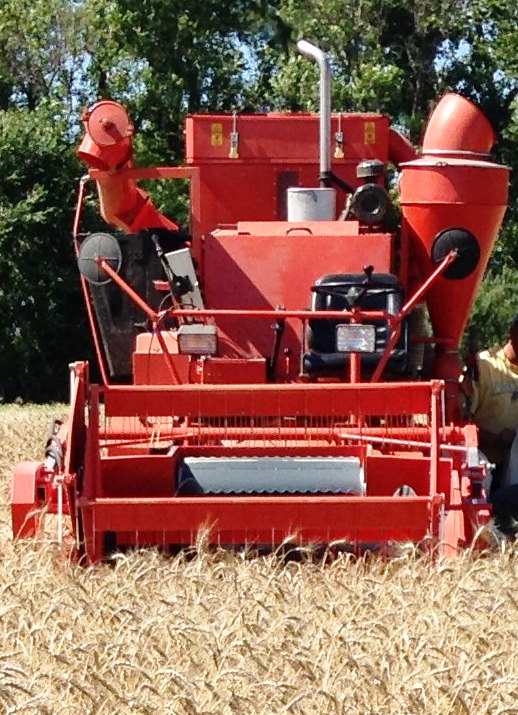
Stay safe this season, whether you are operating equipment or sharing the road with harvesters.
Linda Schuster
Administrative Secretary
Row Crop Tour Set for September 3
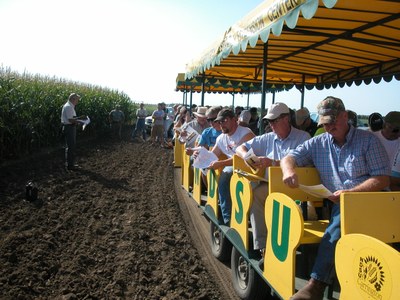
Farmers, crop advisers and agricultural industry representatives will have an opportunity to view field research trials and receive production recommendations on corn, dry edible beans and soybeans at a row crop field tour on Thursday, Sept. 3, at the NDSU Carrington Research Extension Center.
This year’s event will have two parts: a one-hour, white mold management tour beginning at 3:15 p.m. and the main tour at 4:30.
The 3:15 p.m. tour will provide a review of current research and recommendations for managing white mold (Sclerotinia) in dry beans, soybeans and sunflowers. Topics will include:
* Balancing soybean plant populations and row spacing for white mold management and soybean yield
* Irrigation management in fields where white mold is a constraint
* Optimizing fungicide application timing
* Prospects for improving fungicide coverage and white mold disease control through the use of drop nozzles
Topics for the 4:30 main tour include:
* Corn plant populations and nutrient management
* Dry bean plant establishment and nutrient management
* Soybean variety selection and planting dates
* An overview of disease management in dry beans and soybeans, with an emphasis on white mold and soybean cyst nematode
Tour speakers are NDSU Extension Service and research agronomists Greg Endres, Hans Kandel, Mike Ostlie and Blaine Schatz; and plant pathologists Michael Wunsch, Sam Markell, Michael Schaefer and Suanne Kallis.
Participants are encouraged to attend both tours. If choosing to attend only the main tour, please be present at the Carrington center by 4:15 p.m. because tour wagons will leave for the field promptly at 4:30 p.m.
A supper sponsored by associated North Dakota commodity organizations will follow the main tour.
Four continuing education credits will be available for certified crop advisers participating in the event.
Additional information about the tour is available from the Carrington center at (701) 652-2951 or https://www.ag.ndsu.edu/CarringtonREC.
Greg Endres
Area Specialist, Cropping Systems
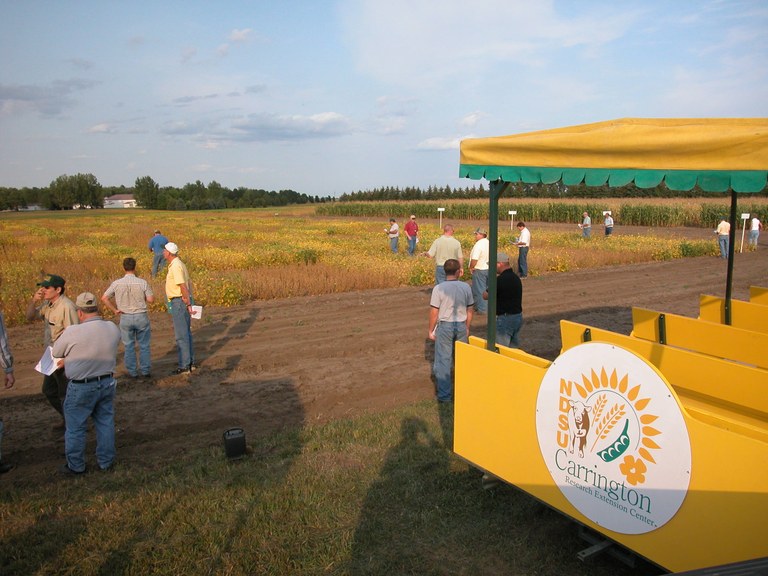
Tour Focused on White Mold Management
A special 1-hour tour focused on white mold management in soybeans, dry beans, and sunflowers will be conducted as part of the Carrington Research Extension Center's annual row crop tour this year.
The white mold tour will be conducted immediately before the customary row crop tour. The row crop tour is on September 3, with the special white mold addition to the tour conducted from 3:15 to 4:15 pm. The normal tour will commence at 4:30 pm, and the tours will conclude with supper at 7:30 pm.
The white mold tour will focus on research trials addressing the following subjects:
- Optimizing plant populations and row spacing for white mold management and maximum yield in soybeans
- Optimizing fungicide application timing for white mold management in soybeans and dry beans
- Prospects for using drop nozzles to improve fungicide coverage and Sclerotinia control in sunflowers, soybeans, and dry beans
- Optimizing irrigation management for maximum dry bean and soybean yield in fields where white mold is an important constraint.
- Efficacy and optimal application timing of Contans, a commercial formulation of the biological control agent Coniothyrium minitans, for management of white mold in soybeans.
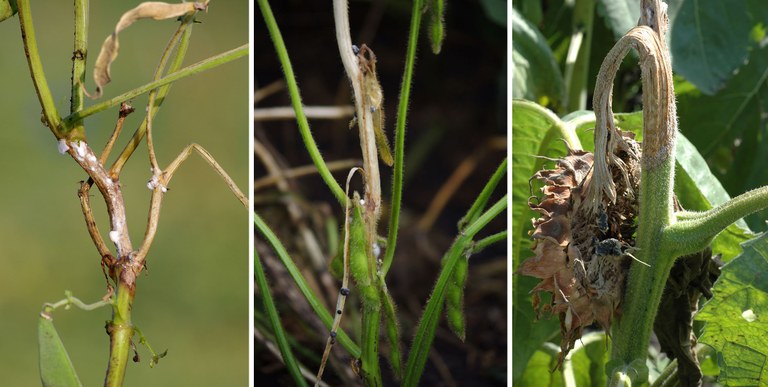
Sclerotinia on a dry bean, soybean and sunflower.
Michael Wunsch
Plant Pathologist
Oakes Irrigation Research Site Field Day
The Oakes Irrigation Research Site Field Day will be held on Thursday, August 20. NDSU’s Oakes research site is located 3.5 miles south of Oakes along U.S. Highway 1.
This Field Day will begin with refreshments at 8:45 a.m. and the tour follows from 9 to 11:45 a.m. The tour will begin with a review of the current research program followed by an update on developments to expand research conducted at the Oakes site.
Other topics include:
- mechanized water management and this fall’s expansion of the OIRS linear irrigation system
- managing white mold (sclerotinia) in soybeans and dry beans
- a review of potato projects at the site and herbicide drift concerns in potato production
- a discussion of corn production practices and a review of corn research projects including research related to residue removal and crop rotations
- a review of recent soybean production research projects and the NDSU soybean breeding program efforts
Lunch will be served following the tour.
The research effort at the Oakes site is made possible through a cooperative agreement between North Dakota State University and the Garrison Diversion Conservancy District (GDCD). The University provides technical staff and the Garrison Diversion Conservancy District provides financial resources. NDSU faculty and staff from the departments of Soil Science, Plant Sciences, Agricultural and Biosystems Engineering, Plant Pathology, Plant Sciences, Soil Science and the Carrington Research Extension Center participate in conducting experiments at the Oakes site.
This collaboration between NDSU and the GDCD has been ongoing since 1970 and is strategically placed south of Oakes on land representative of irrigated acreage of the region. Throughout these years the site has been located on land owned by Robert and Elsie Titus.
For more information, contact the Carrington Research Extension Center at (701) 652-2951 or visit https://www.ag.ndsu.edu/CarringtonREC .
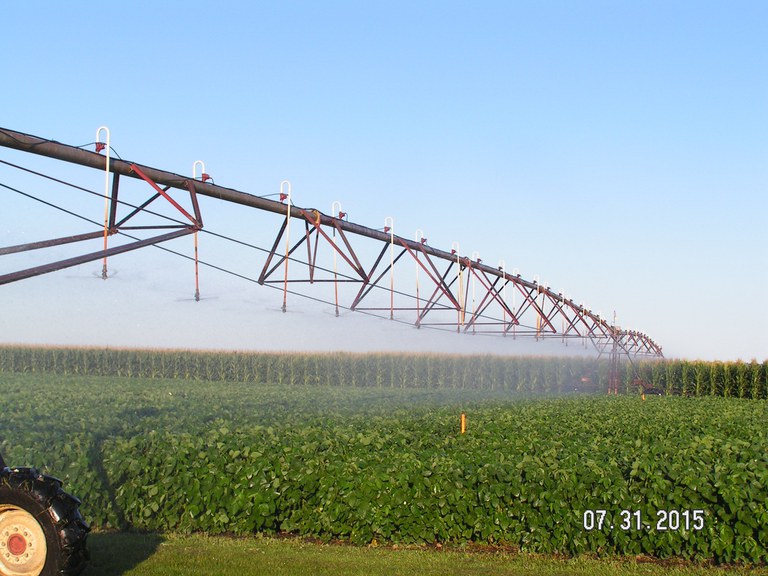
The soybean sclerotinia study at the Oakes research site includes impacts related to water management, timing, row spacing, and fungicide treatments.
Linda Schuster
Administrative Secretary


